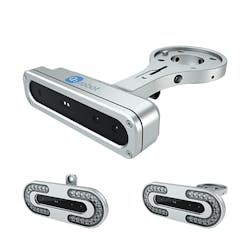One of the first real-world applications of IoT (Internet of Things) technologies that provided tangible benefits to manufacturers of all sizes involved optimizing equipment maintenance via the addition of sensors to gather more data. Similarly, the addition of vision systems to robots is rapidly advancing the use of robots beyond their initial areas of application.
But understanding how vision technologies can expand robot capabilities is just one important aspect of this automation technology combination. Two other factors are: How to determine if you really need robot vision technologies and how to choose the right kind of camera for your system if you do.
In any consideration of vision system technology, the first thing to understand is how much easier the incorporation of vision technologies into robotic systems has become. Not so long ago, vision systems were often viewed as being complex, expensive, and difficult to integrate. However, several new vision technologies have emerged in the past few years that are notable for their reduced cost factors and ease of integration and use, especially for cobot (collaborative robot) applications.
Why add vision to robots?
If you’ve ever been to an industry trade show featuring robots, you know that robots can work very effectively without vision capabilities. However, if you need a robot to be able to pick and place different objects or handle objects in different orientations, the addition of vision technology is critical.
In such scenarios, OnRobot (a supplier of cobot systems, end effector tools, sensors, and software) says the addition of a camera and associated software to your production lines. According to the company, vision systems can bring “flexibility to your operations, enabling you to switch between different products easily. And vision dramatically reduces the time required to move between one product and another.”
But with so many different types of robot vision systems on the markets, how do you determine which one is right for your application?
Understanding camera types
According to OnRobot, robot cameras are most commonly 2D, 3D or 2.5D.
Though 2D cameras are the cheapest of the three types, OnRobot notes that they are reliable, but also the least versatile. “Typically, 2D cameras determine length and width (X and Y axis), but are unable to determine height, which limits the number of applications they can support,” says OnRobot.
3D cameras provide all the visual information a robot could possibly need, covering all three axes and incorporating object rotation. OnRobot notes that this functionality does, of course, come with a higher price tag. The company adds that 3D vision systems can also be more difficult to integrate and operate than 2D or 2.5D cameras.
If a 2.5D camera seems appropriate for your application, OnRobot recommends exploring the set up and calibration requirements of the cameras you’re choosing among. “Some 2.5D cameras must be attached directly to your cobot, which restricts their capabilities,” and some come with sub-optimal software.
Eyes is OnRobot’s 2.5D camera and vision system that can be used on most collaborative and light industrial robot arms.
According to OnRobot, Eyes can be mounted anywhere within the production cell rather than requiring integration into the robot arm or attached to the robot's wrist, as is required with some robot vision systems. This external mounting capability eliminates the issue of cables running alongside your robot, which can potentially restrict movement. The company says this external mounting option also allows users to “optimize cycle time, because Eyes can take care of image capture and processing while your robot is working on another operation. In addition, Eyes can be calibrated using just one picture.”
About the Author
David Greenfield, editor in chief
Editor in Chief

Leaders relevant to this article:

